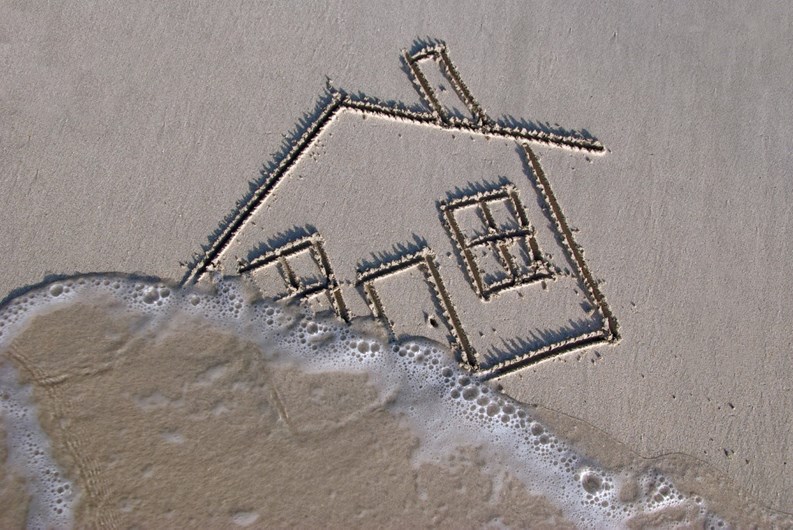As homeowner insurance costs continue to escalate in the coastal regions of New England, it has become harder to successfully wade through the morass of deductibles and policy lingo on storm insurance coverage. But with a little knowledge and shopping around, you can balance adequate coverage with reasonable expense, leaving your condo sufficiently protected when storms darken the horizon.
Many condominium or co-op owners are under the mistaken – and often very costly –impression that the association’s insurance policy will be enough to pay for damages incurred by storms. Getting to know the community association bylaws and the master insurance policy is the first step in making sure that unit owners get the proper coverage they need. The master policy’s coverage of condo units can range from “bare walls” – only covering from the outside walls of the individual unit out; to “all-in” coverage – which extends coverage to all permanent fixtures in the unit.
For best coverage, the unit owner’s HO-6 insurance policy should be designed to fill the holes of the master policy. Generally speaking, a basic HO-6 policy covers a unit owner’s personal property, interior walls and floor coverings, improvements and upgrades from a specific list of “covered perils” –things like wind, fire, or flooding from broken pipes, to name a few.
Christine Watson, commercial lines manager with Global Insurance Network Inc. of Needham, Massa-chusetts, also advises unit owners to add what’s called a special coverage endorsement to their HO-6. “It extendsyour coverage from all named perils,” she says.
Know What’s Covered
“It’s extremely important for unit owners to know their association’s bylaws,” stresses Scott Kerry, owner of Kerry Insurance on Cape Cod. “You need to get to the very essence of who owns what and who is responsible for what in the event of damage.” If the master policy only covers units to the wall studs, for example, the unit owner is then responsible for everything beyond that, including the sheetrock, paint or wallpaper. If the roof gets blown off in a storm, the master policy may cover the roof repair, but not the water damage that subsequently ruined your ceiling, walls, or kitchen cabinets.
Because there are so many variations of ownership among associations and unit owners, Kerry recommends finding an insurance agent who will really take the time to inspect the bylaws so that the individual policy [HO-6] will supplement the coverage of the master policy. “Get a copy of the bylaws and the master insurance policywhen planning your own policy,” he says. “You can’t write one policy without the other.”
Unit owners will also want to be aware of the master policy’s deductibles for damage to common areas. Typically, all unit owners must contribute money to reach the deductible, and depending on this dollar amount and the number of owners pitching in, this could have major impact. Suppose that deductible is $20,000 and there are only four unit owners chipping in? That’s an instant $5,000 out of pocket, just for common areas and not counting any damage thatmay also affect your own property.
“It goes back to knowing exactly what’s covered under the master policy,” says Watson. “Many associations, as a way to keep their own costs down as well as to discourage the filing of a lot of small claims by residents, will keep their deductibles quite high. The unit owner’s policy should act to fill in the gap to cover the difference.” If the master policy deductible for a particular damage is $5,000, and the unit owner’s deductible is $500, that difference could mean significant savings at payout time.
When choosing deductibles, says Paul Tetrault, Northeast state affairs manager of the National Association of Mutual Insurance Companies (NAMIC), you have to find an amount you are comfortable with. “You’ve got to think about your circumstances and what you can afford. Higher deductibles can result in significant savings on your premiums, but would also mean a much higher out-of-pocket cost shoulddamage occur.”
When it comes to big storm coverage, like hurricanes and the floods that often accompany them, the right insurance coverage is essential. The devastation experienced in Texas, Florida, Mississippi, and New Orleans in recent years has put both insurance companies and coastal residents on edge. Fears of a major hurricane striking the New England coast – based on more sophisticated storm calculators as well as the sense that the region is due for “the big one” – have insurancecompanies increasing premiums at alarming rates. Even when no claims have been filed, homeowners have seen their policies double and triple in cost.
What’s happened, says Tetrault, is that “hurricane risk has changed the nature of insurance.” Looking back at Katrina, Wilma, and 2007’s Ike, what also has changed is “the understanding of the nature of hurricane risk. Insurance companies are exposed to far more catastrophic loss than they can handle. To address the newly-understood reality of their exposure, insurers in coastal markets have been raising rates to cover higher reinsurance costs, requiring insureds to implementmitigation measures, applying higher deductibles, and reducing business through non-renewals,” he says.
Rhode Island Reform
Most of the New England states – with the exception of Vermont and New Hampshire – have laws regardinghurricane deductibles, though it’s the insurance companies that determine the rates and when they should apply.
The limits on hurricane deductibles are important because in many high-risk coastal areas – such as Rhode Island – such deductibles require either a flat-rate dollar amount or the potentially much more expensive percentage figure. Insurers set these rates; in some cases, they give homeowners a choice between the flat or percentage rate. More often than not, however, insurance companies are making the percentage deductible mandatory. That percentage rate, usually between 2% and 5%, is based not on the cost of the damage itself, but rather the value of the home or condominium unit. For example: in the event of $30,000 in hurricane damage, the unit owner pays a deductible of 2%-5% of the total value – say $300,000 – of their property, and not 2%-5% of the $30,000.
Several states are looking to ease the burden on homeowners through legislation, and Rhode Island is in the forefront. State Representative Brian Patrick Kennedy (D-38, Hopkinton, Westerly), who is also the chair of the House Committee on Corporations, has sponsored a bill (H-5275) that would restrict insurers’ ability to applyhurricane deductibles.
Likening the skyrocketing cost response of insurance companies to “Chicken Little,” Kennedy is looking to close the loophole in current legislation in which insurance companies can invoke hurricane deductibles when only a hurricane warning is issued but hurricane force winds do not follow. Under H-5275, hurricane deductibles could only be applied when hurricane-force sustained winds are reported by the National Weather Service from within the state.
“The current law triggers once a hurricane warning has been issued and, for the next 24-hour period, the hurricane deductible applies to any losses, even if there is significant wind damage without an actual hurricane. Under the present law, a hurricane deductible would apply if a property owner suffered damage, even if the hurricane never actually reached the shores of the Ocean State,” says Kennedy.
“This bill ensures that if a hurricane does not actually hit the state but we are dealing with gale force winds, or a microburst, or a Nor’easter, then the damages will be covered by the regular insurance policy and homeowners will not be saddled with an inflated hurricane deductible of anywhere from 1 percent to 5 percent of the total insured value of their home,” said Representative Kennedy.
The bill was just signed into law and was slated to become effective August 1.
Flood Insurance
Obtaining their own flood insurance (through the federal government) is another very serious consideration for unit owners, says the Federal Emergency Management Agency (FEMA). “Unit owners in apartment-style condo buildings have a financial interest in the condominium building, as well as in the building elements within their unit. Obviously, a unit owner can’t insure the entire building, but can encourage the condominium association to purchase adequate flood insurance protection for the entire building. Flood insurance protection for eligible residential buildings and building elements within individual units is most cost efficientlymanaged by the condominium association under the Residential Condo-minium Building Association Policy (RCBAP).”
Your cost for coverage will depend on where your home fits on the flood zone maps; each flood zone describes that land area in terms of its risk of flooding. According to FEMA, everyone lives in a flood zone –it's just a question of whether you live in a low, moderate, or high-risk area.
Flood insurance covers “overflow of inland or tidal waters and unusual and rapid accumulation or runoff of surface waters from any source. However, the flood must be a general and temporary condition of partial or complete inundation of two or more acres of normally dry land area or of two or more properties (at least one of which is yours),” according to the floodsmart.gov website.
It’s important to note that flood damage from wind-driven rain is not covered. When rain enters through a wind-damaged window or door, or comes through a hole in a wall or roof, the NFIP considers the resulting puddles and damage to be windstorm-related, not flood-related.
The bottom line? It pays to shop around when looking to protect your assets from storm damage. With advanced preparation and a little homework, you can ride out the storm with the comfort of knowing that your unit and the association are adequately covered when the winds begin to blow.
Laura Scheel is a freelance writer and a frequent contributor to New England Condominium magazine.







Leave a Comment